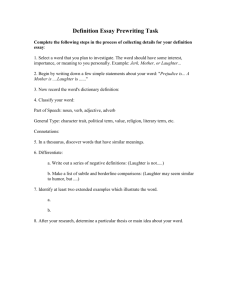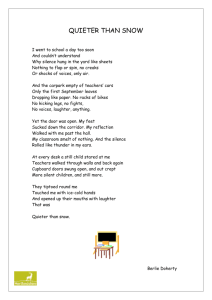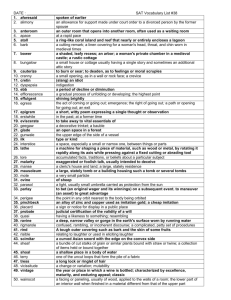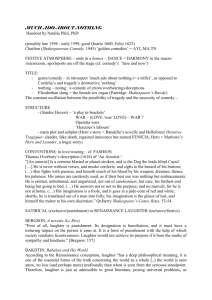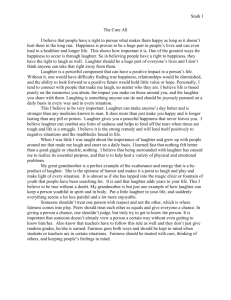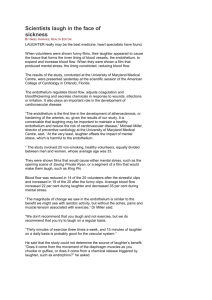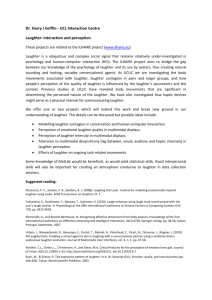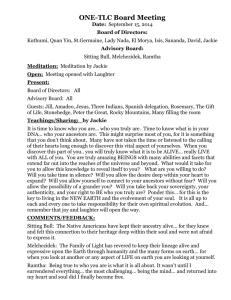Doctoral Thesis (Tokyo University of Foreign Studies)
advertisement
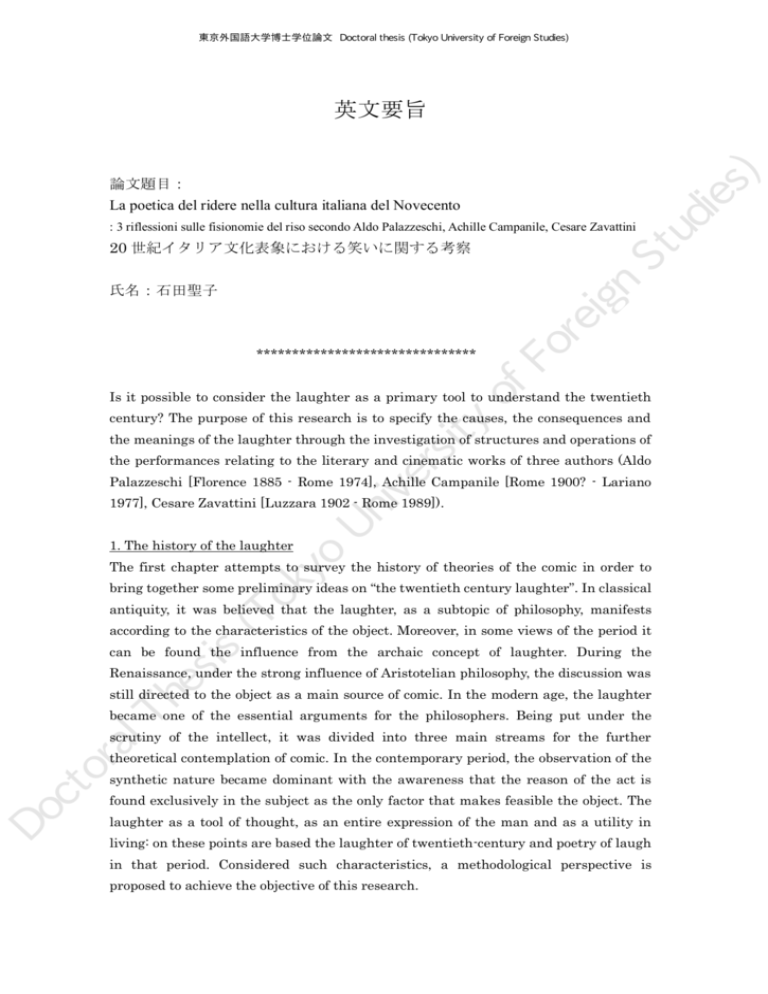
東京外国語大学博士学位論文 Doctoral thesis (Tokyo University of Foreign Studies) s) 英文要旨 St ud ie 論文題目: La poetica del ridere nella cultura italiana del Novecento : 3 riflessioni sulle fisionomie del riso secondo Aldo Palazzeschi, Achille Campanile, Cesare Zavattini 20 世紀イタリア文化表象における笑いに関する考察 of ******************************* Fo re ign 氏名:石田聖子 Is it possible to consider the laughter as a primary tool to understand the twentieth ity century? The purpose of this research is to specify the causes, the consequences and rs the meanings of the laughter through the investigation of structures and operations of ive the performances relating to the literary and cinematic works of three authors (Aldo Palazzeschi [Florence 1885 - Rome 1974], Achille Campanile [Rome 1900? - Lariano (T ok yo 1. The history of the laughter Un 1977], Cesare Zavattini [Luzzara 1902 - Rome 1989]). The first chapter attempts to survey the history of theories of the comic in order to bring together some preliminary ideas on “the twentieth century laughter”. In classical antiquity, it was believed that the laughter, as a subtopic of philosophy, manifests according to the characteristics of the object. Moreover, in some views of the period it es is can be found the influence from the archaic concept of laughter. During the Renaissance, under the strong influence of Aristotelian philosophy, the discussion was Th still directed to the object as a main source of comic. In the modern age, the laughter became one of the essential arguments for the philosophers. Being put under the al scrutiny of the intellect, it was divided into three main streams for the further Do ct or theoretical contemplation of comic. In the contemporary period, the observation of the synthetic nature became dominant with the awareness that the reason of the act is found exclusively in the subject as the only factor that makes feasible the object. The laughter as a tool of thought, as an entire expression of the man and as a utility in living: on these points are based the laughter of twentieth-century and poetry of laugh in that period. Considered such characteristics, a methodological perspective is proposed to achieve the objective of this research. 東京外国語大学博士学位論文 Doctoral thesis (Tokyo University of Foreign Studies) 2. The divine laughter of Aldo Palazzeschi Aldo Palazzeschi is not only the theoretician of the twentieth century laughter with Il Controdolore (1914), but also a creator of meaningful representations in his first three collections of poems (I cavalli bianchi [1905]; Lanterna [1907]; Poemi [1909]) and in Il St ud ie show the evolution of the modern subject. Such solution is theorized in the futurist s) Codice di Perelà (1911). The analysis starts with an examination of his poems that manifest which asserts that the laughter is adopted to make use of its divine power, or simply to cancel the existing images and to prepare the perceptual “tabula rasa” for a new creation. Palazzeschi’s laughter is conceived related to the pain. Such laughter, which is a synonymous of joy, opposes clearly to the pain, deriving precisely from this re ign last one, retaining a proportional relationship with it. In the latter part of the chapter, the writer tries to specify the reason for the amorphous form of the Perelà’s body Fo through the phenomenological observation of the smoke extending the concept of the grotesque while it becomes important the examination of the language that concern of him in order to find the identity that suits his body conditions. Determined by the impossibility to obtain definite meanings of the existence, Perelà, a model of the ity modern man, is nothing but man-demiurge who is inspired by the capabilities of the ive rs own body. 3. The human laughter of Achille Campanile Un Achille Campanile is an inventor of an appropriate language for the twentieth century laughter. His interdisciplinary approach is evident also at the phenomenal level: (T ok yo Campanile’s multifaceted activities which are developed in various fields (journalism, theater, cinema, television, literature) extend to a wide, unique and diverse field. On the one hand, it makes Campanile a successor to the traditional popular spectacle of Italy, but on the other hand, it makes him as a pioneer of modern artist. His writing makes use of cinematic techniques. Ma che cosa è quest’amore? (1927) is composed by es is the montage technique. Structured in this way, the work has a typical cinematic perspective: the gag requires the reversal in the vision and the description is limited to Th the surface as if it has been shot by the camera. Such techniques form an another universe with an another logic. In his narrative, irony emerges as a key concept. It al consists in saying what is contrary to what someone really wants to transmit, falling in Do ct or contradiction purposely in order to access a deeper wisdom and encouraging the active intervention of the interlocutor. Campanile’s ironic attitude shows its effect in the television critiques which are partially collected in a volume entitled La televisione spiegata al popolo (1989). Campanile’s inventions confirm the validity of the paradox with regard to the existential conditions of the period: Campanile’s narrative, which uses the negative to emphasize the positive, can be one of the practical ways allowed to humankind to approach the inscrutable world without falling into megalomaniacs illusions. 東京外国語大学博士学位論文 Doctoral thesis (Tokyo University of Foreign Studies) 4. The diabolic laughter of Cesare Zavattini The third and last author is Cesare Zavattini. Zavattini, who is considered antithetical to Campanile, develops the twentieth century laughter into a concrete form which belongs to another dimension: the one of cinema. Then he tries to broaden St ud ie analysis moves from the comparison of Campanile and Zavattini in order to highlight s) the horizons of human intimacy as much as possible making use of various media. The the differences between their narrative. The extraordinary self-interest remains in the essence of Zavattini’s poetic and then, it attempts to define such “I” through the examine of the "three books" (Parliamo tanto di me [1931], I poveri sono matti [1937], Io sono il diavolo [1941]). The idea that Zavattini’s I is equal to others and that the re ign word "devil" is designated as such is developed taking into account the concepts and the related representations about the mirror. It is indeed the awareness of the need for Fo such moments of reflection to make Zavattini choose first the humor, another typical form of the twentieth century laughter, and then the cinema. Both, as instructive of media, divide reality into a real form and a virtual one, introducing an affective distance in the middle. Such distance enables any form of reflection that unifies the rs ity two realities in order to make a qualitative leap in thinking. ive In conclusion, according to a number of considerations in this study, the poetics of laughter occurs in the dynamism of creation in order to make relative the pain of Do ct or al Th es is (T ok yo Un existence which is typical for the twentieth century.
